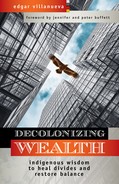
PART TWO
How to Heal
In order to embrace a new paradigm of connect, relate, belong, instead of divide, control, exploit, we first have to heal. The metaphor of healing reflects my stance in the reform vs. revolution debate. Some will say that the colonial system of wealth consolidation based on white supremacy has caused so much damage and suffering and is so intrinsically rotten that anything related to it, including the ostensibly altruistic worlds of philanthropy or aid, cannot be fixed, cannot be trusted, should not be saved. Those voices would burn the system to the ground and start fresh. I empathize with that perspective, yet I believe there are parts of the system worth holding on to. The both/and stance is how Native Americans have survived colonization. Evolution occurs both by holding on to the adaptations that keep us thriving, and also abandoning the elements that keep us from thriving.
![]()
Every time we contemplate huge goals like social justice and equity, or a slightly smaller goal like real evolution inside the field of finance or philanthropy, we encounter beliefs about what is possible. What is pragmatic and realistic, and what is idealistic or utopian? I expect that some of the Seven Steps to Healing will be considered radical by large, long-standing institutions. There will be those who say my proposals are too far out there, a fantasy, pie in the sky.
This is the tension that we face in evolving. People who rely on the current system are afraid to dismantle it, because when we’re out in the middle of the ocean during the perfect storm, no land in sight, who’s going to poke holes in the only lifeboat we have, even if it’s a terrible vessel?
There is always this abyss. On one side of it are the pragmatists, saying this is just the way things are, we have to make the best of it, things never change, it’s human nature. On the other side of the abyss are the idealists, imagining another world, building utopias. Some of the hardest work involves crisscrossing the abyss, understanding both positions, and seeking ways to bridge them. Evolving a complex set of systems, like white supremacy and capitalism, and long-standing institutions like governments, banks, and foundations, requires bridge builders who can envision opportunities for change and lead with compassion.
Marginalization and oppression seem to stifle the imagination—among both those who suffer and those who benefit from the current transactional systems of wealth. Unfortunately, the majority of our groundbreaking and inspiring idealists are part of the powerful elite, holding all the high cards of privilege: think of players like Elon Musk and Richard Branson. We need to populate the idealist side of the abyss with different kinds of people who have different visions of future possibilities. Much has been written about how colonizers rewrite the history of the places and the people they colonize. Part of keeping total control is staking a claim on the past. But colonizers also control the future. They control what is imaginable.
The idealists yell over the abyss that the sheep stuck in the status quo are cowards. The pragmatists shout back that the idealists are out of touch with reality. One response to the pragmatists is to question their certainty that this is indeed reality. We can be like Neo in The Matrix taking the red pill and seeing the constructed world as an illusion. “The willingness to own up to the fictional nature of our story is where the healing begins,” writes Peter Block in his book on civic engagement, Community.1
White supremacy is just a story humans created. Race is just a story humans created. Resources as scarce, greed as an inescapable aspect of human nature, and money as the root of evil—all these are stories. Over time, these stories have become so solidified and familiar and “true” that they began limiting our view of the world and our choices. They became beliefs, articles of faith. Yet our beliefs are just one perspective, and the more rigid our perspective, the more alternative perspectives we miss.
Once we understand that the stories are optional—choices we made—we can choose to let go of any beliefs that limit us. Every obstacle can be incorporated and can become an ally, another beautiful aspect of authentic wholeness. A free imagination is key to overcoming limiting beliefs.
The central question at the foundation of much science fiction—“What if . . .?”—is a legitimate tool of healing and reconstructing the world. Even just asking the question opens us to radically different possible realities and can lead to healing, to a greater sense of dignity and purpose. The film Black Panther allowed us to imagine a fictionalized nation of unfathomable wealth that refuses to play by the rules of divide-control-exploit, to imagine a world where Black people triumph. #WakandaForever
What if funders could help restore a perfect world? What if money could be medicine, instead of what divides us? What if rather than using wealth to cause further harm, we followed the Seven Steps to Healing?
